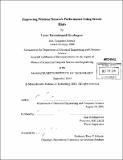| dc.contributor.advisor | Hari Balakrishnan. | en_US |
| dc.contributor.author | Sivalingam, Lenin Ravindranath | en_US |
| dc.contributor.other | Massachusetts Institute of Technology. Dept. of Electrical Engineering and Computer Science. | en_US |
| dc.date.accessioned | 2011-04-25T15:57:51Z | |
| dc.date.available | 2011-04-25T15:57:51Z | |
| dc.date.copyright | 2010 | en_US |
| dc.date.issued | 2010 | en_US |
| dc.identifier.uri | http://hdl.handle.net/1721.1/62432 | |
| dc.description | Thesis (S.M.)--Massachusetts Institute of Technology, Dept. of Electrical Engineering and Computer Science, 2010. | en_US |
| dc.description | Cataloged from PDF version of thesis. | en_US |
| dc.description | Includes bibliographical references (p. 59-62). | en_US |
| dc.description.abstract | Users of wireless devices often switch between being stationary and in motion while transferring data. Protocols that perform well in the static setting (where the channel conditions are relatively stable), however, tend to perform poorly when in motion (where channel conditions change rapidly), and vice versa. To circumvent this problem, we note that commodity smartphones and tablet devices come equipped with a variety of sensors, including accelerometers, multiple positioning sensors, magnetic compasses, and inertial sensors (gyros) that can provide hints about the device's mobility. In this thesis, we posit that these sensors can be profitably used to improve the performance of wireless network protocols running on these mobile devices and introduce an architecture for using external sensor hints for this purpose. We validate this idea with many different wireless protocols. First, we show how access points can perform better rate adaptation by changing strategies when they receive hints about a client's mobility. Second, we show how probing protocols for topology maintenance in mesh networks can increase both their efficiency and accuracy by adaptively probing based on movement. Third, we show how vehicular mesh networks can use directionality hints to improve the connectivity of routes. Finally, we outline several other novel applications of external sensor hints for improving wireless network performance. We evaluate our protocols using trace-driven simulation and real-world experiments. We show that our hint-aware rate adaptation protocol increases throughput by 30% to 50% on average over frame-based and SNR-based protocols. Our hint-aware probing protocol reduces the bandwidth consumed by probing to accurately estimate link delivery probabilities-by a factor of 20 in our experiments. And, our hint-aware route selection in vehicular mesh networks increases route stability by a factor of 4 to 5 compared to a hint-free approach in our simulations. | en_US |
| dc.description.statementofresponsibility | by Lenin Ravindranath Sivalingam. | en_US |
| dc.format.extent | 62 p. | en_US |
| dc.language.iso | eng | en_US |
| dc.publisher | Massachusetts Institute of Technology | en_US |
| dc.rights | M.I.T. theses are protected by
copyright. They may be viewed from this source for any purpose, but
reproduction or distribution in any format is prohibited without written
permission. See provided URL for inquiries about permission. | en_US |
| dc.rights.uri | http://dspace.mit.edu/handle/1721.1/7582 | en_US |
| dc.subject | Electrical Engineering and Computer Science. | en_US |
| dc.title | Improving wireless network performance using sensor hints | en_US |
| dc.type | Thesis | en_US |
| dc.description.degree | S.M. | en_US |
| dc.contributor.department | Massachusetts Institute of Technology. Department of Electrical Engineering and Computer Science | |
| dc.identifier.oclc | 710993771 | en_US |
